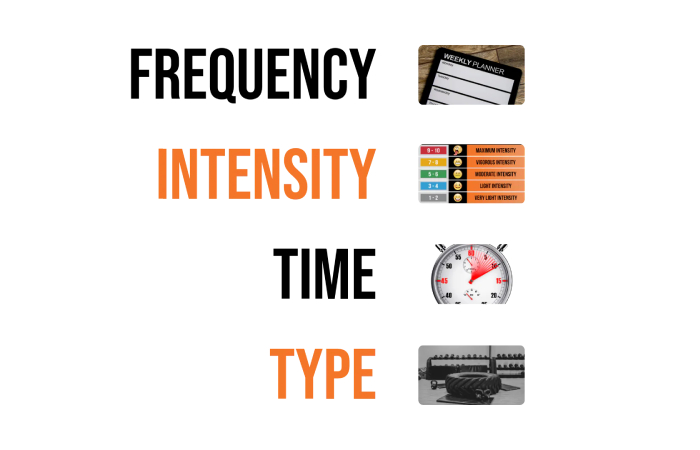Explain How the FITT Principle Applies to The Development of A Successful Personal Fitness Program

Explain How the FITT Principle Applies to The Development of A Successful Personal Fitness Program – Ever feel like your workout routine is stuck in a rut?
Maybe you’re not seeing the desired results or just bored with your current routine.
Enter the FITT principle – your secret weapon for creating a killer personal fitness program.
Let’s dive into how this simple but powerful concept can transform your fitness journey.
What’s the FITT Principle Anyway?

FITT is an acronym that stands for:
- Frequency
- Intensity
- Time
- Type
These four elements are the building blocks of any effective workout plan.
You can create a fitness program perfectly tailored to your goals and lifestyle by tweaking these factors.
Let’s break it down and see how each component applies to your fitness journey.
F is for Frequency: How Often Should You Work Out?
Frequency refers to how often you exercise.
It’s all about finding that sweet spot between pushing yourself and giving your body time to recover.
Here’s how to nail your workout frequency:
- Aim for at least 3-5 days of exercise per week
- Space out your workouts to allow for recovery
- Consider your fitness goals—weight loss might require more frequent sessions, while muscle building might require more rest days.
Remember, consistency is critical.
It’s better to work out 3 times a week every week than to go hard for 7 days and then burn out.
I is for Intensity: Pushing Your Limits (Safely)
Intensity is all about how hard you’re working during your exercises.
It’s the difference between a walk in the park and a sweat-dripping, heart-pumping workout.
Here’s how to get your intensity right:
- Use the “talk test” – if you can easily carry a conversation, you might need to up the intensity
- Monitor your heart rate – aim for 50-85% of your maximum heart rate, depending on your fitness level
- Gradually increase intensity over time to keep challenging yourself
- Listen to your body – pushing too hard too fast can lead to injury
The right intensity will have you feeling challenged but not completely wiped out.
T is for Time: How Long Should Your Workouts Be?
Time refers to the duration of your workout sessions.
It’s not just about spending hours in the gym—it’s about making the most of your time.
Here’s how to optimize your workout time:
- Aim for at least 150 minutes of moderate-intensity exercise per week
- Break it up into manageable chunks – three 50-minute sessions or five 30-minute sessions
- Consider your schedule – shorter, more intense workouts can be just as effective if you’re short on time
- Balance your time across different types of exercise – cardio, strength training, flexibility work
Remember, quality beats quantity.
A focused 30-minute workout can be more effective than an hour of half-hearted exercise.
T is for Type: Choosing the Right Exercises
Type refers to the kind of exercise you’re doing.
The best fitness programs include various exercise types to work out different aspects of your fitness.
Here’s how to mix up your exercise types:
- Include both cardio and strength training in your routine
- Try different cardio activities – running, cycling, swimming, dance classes
- Experiment with various strength training methods – free weights, machines, bodyweight exercises
- Don’t forget about flexibility and balance work – yoga, pilates, stretching
The key is to find the types of exercise that you enjoy.
You’re more likely to stick with a fitness program if you like what you’re doing.
Putting It All Together: Creating Your Fitness Program

Now that we’ve broken down the FITT principle let’s see how to apply it to create your kickass fitness program.
- Set clear goals: What do you want to achieve? Weight loss? Muscle gain? Better endurance?
- Assess your current fitness level: Be honest with yourself. This will help you set realistic starting points for each FITT component.
- Plan your frequency: Decide how many days a week you can commit to working out.
- Determine your intensity: Start at a level that challenges you but doesn’t overwhelm you, and plan to increase gradually.
- Set your time: Look at your schedule and decide how long your workout sessions can be.
- Choose your types: Pick a variety of exercises that align with your goals and that you enjoy.
- Create a schedule: Map out your week, specifying what type of exercise you’ll do each day, for how long, and at what intensity.
- Track your progress: Keep a workout log to see how you improve over time.
- Adjust as needed: As you get fitter, you must tweak your FITT components to keep challenging yourself.
Remember, the best fitness program is one that you’ll stick to.
Be realistic, consistent, and ready to adapt as you go along.
FAQs on Explain How the FITT Principle Applies to The Development of A Successful Personal Fitness Program
Q: How often should I change up my fitness routine?
A: To prevent boredom and plateaus, making small changes every 4-6 weeks is good. This could be as simple as changing the order of your exercises or trying a new class.
Q: Can I apply the FITT principle if I’m a beginner?
A: Absolutely! The FITT principle is great for beginners because it helps you start at an appropriate level and progress gradually.
Q: How do I know if I’m making progress?
A: Look for signs like being able to work out for longer, lift heavier weights, or perform exercises with better form. Also, pay attention to how you feel—increased energy and a better mood are great progress indicators.
Q: What if I miss a workout?
A: Don’t sweat it! Just get back on track with your next scheduled session. What matters is consistency over time, not perfection.
Q: How do I avoid injury when increasing intensity?
A: Increase intensity gradually – no more than 10% per week. Always warm up properly and listen to your body. If something feels off, ease back.
The FITT principle isn’t just a set of guidelines – it’s a framework for creating a fitness program that evolves with you.
By regularly assessing and adjusting these four key components, you can keep your workouts challenging, effective, and enjoyable.
So, ready to FITT your way to fitness success?
Let’s get moving!
